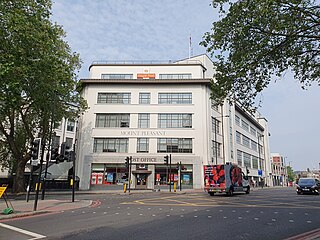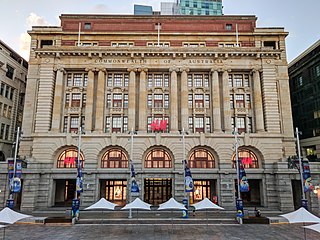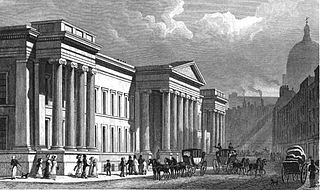
A post office is a public facility and a retailer that provides mail services, such as accepting letters and parcels, providing post office boxes, and selling postage stamps, packaging, and stationery. Post offices may offer additional services, which vary by country. These include providing and accepting government forms, and processing government services and fees. The chief administrator of a post office is called a postmaster.

Dublin 2, also rendered as D2 and D02, is a historic postal district on the southside of Dublin, Ireland. In the 1960s, this central district became a focus for office development. More recently, it became a focus for urban residential development. The district saw some of the heaviest fighting during Ireland's Easter Rising.

The Postal Museum is a postal museum run by the Postal Heritage Trust. It began in 2004 as The British Postal Museum & Archive and opened in Central London as The Postal Museum on 28 July 2017.

St. Martin's Le Grand is a former liberty within the City of London, and is the name of a street north of Newgate Street and Cheapside and south of Aldersgate Street. It forms the southernmost section of the A1 road. For many years St. Martin's Le Grand was "often used as a synonym for the chief postal authorities, as Scotland Yard is used to designate the police", the headquarters of the General Post Office having been there from 1829-1984.

The Mount Pleasant Mail Centre is a mail centre operated by Royal Mail in London, England. The site has previously operated as one of the largest sorting offices in the world. It is located in the London Borough of Islington, on the boundary with the London Borough of Camden.

The General Post Office is a heritage landmark building in Perth, Western Australia. Located on the western side of Forrest Place in the city's central business district, its imposing stone facade is in the Beaux-Arts style. The building was completed in 1923 after almost a decade of construction, which was protracted by World War I and the resulting shortages of construction materials. At the time of its opening, it was the largest building in Perth.

The General Post Office (GPO) was the state postal system and telecommunications carrier of the United Kingdom until 1969. Established in England in the 17th century, the GPO was a state monopoly covering the dispatch of items from a specific sender to a specific receiver ; it was overseen by a Government minister, the Postmaster General. Over time its remit was extended to Scotland and Ireland, and across parts of the British Empire.

The General Post Office in St. Martin's Le Grand was the main post office for London between 1829 and 1910, the headquarters of the General Post Office of the United Kingdom of Great Britain and Ireland, and England's first purpose-built post office.

Chennai General Post Office (GPO) is located on Rajaji Salai at Parry's Corner, Chennai. It functions in a building built in 1884. It is located opposite to the Chennai Beach suburban railway station. Chennai GPO covers an area of about 23.33 km2 (9.01 sq mi) and serves a population of around 220,000. It has no sub-branch offices.

The General Post Office, situated on the corner of Elizabeth and Bourke streets in Melbourne, is the former General Post Office for Victoria, Australia.

The Port Pirie Post Office is a heritage-listed post office at 79-83 Ellen Street, Port Pirie, South Australia. It was designed by Edward Woods and built in 1880, with extensions designed by Charles Owen-Smyth built in 1905–1907. It was added to the South Australian Heritage Register on 12 October 1995 and added to the Commonwealth Heritage List on 8 November 2011.

The Paddington Post Office is a heritage-listed post office located at 246 Oxford Street in Paddington, a suburb of Sydney, Australia. The post office is owned and operated by Australia Post. The building was also a former telephone exchange. It was designed by the New South Wales Colonial Architect's Office under James Barnet and later Walter Liberty Vernon, and was built by William Farley. The building was added to the Commonwealth Heritage List, the New South Wales State Heritage Register on 22 December 2000, and the Register of the National Estate.

Newcastle Post Office is a heritage-listed former post office at 96 Hunter Street, Newcastle, New South Wales, Australia. It was designed by Walter Liberty Vernon in his capacity as New South Wales Government Architect and was built from 1900 to 1903 by R. Saunders (freestone), Loveridge & Hudson (trachyte), Mountney & Co., Chas Dobson & Co. and J. P. Woods. It was added to the New South Wales State Heritage Register on 22 December 2000.

The Bull and Mouth Inn was a coaching inn in the City of London that dated from before the Great Fire of London in 1666. It was located between Bull and Mouth Street in the north and Angel Street in the south. It was once an important arrival and departure point for coaches from all over Britain, but particularly for the north of England and Scotland. It became the Queen's Hotel in 1830 but was demolished in 1887 or 1888 when new post office buildings were built in St Martin's Le Grand.

Tumut Post Office is a heritage-listed post office at 82–84 Wynyard Street, Tumut, New South Wales, Australia. It was added to the Australian Commonwealth Heritage List on 22 August 2012.

Cronulla Post Office is a heritage-listed post office at 41 Cronulla Street, Cronulla, Sydney, New South Wales, Australia. It was designed by Edwin Hubert Henderson of the Commonwealth Department of Works and Railways and built in 1924. It was added to the Australian Commonwealth Heritage List on 22 August 2012.

Hamilton Post Office is a heritage-listed post office at 57 Gray Street, Hamilton, Victoria, Australia. It was designed by C. H. E. Blackman of the colonial Public Works Department under the aegis of William Wardell, built in 1876, and occupied in 1878. It was added to the Australian Commonwealth Heritage List on 8 November 2011.

Kyneton Post Office is a heritage-listed post office at 113 Mollison Street, Kyneton, Victoria, Australia. It was designed by Peter Kerr of the colonial Public Works Department and built in 1870–71. It was added to the Australian Commonwealth Heritage List on 8 November 2011.

Launceston Post Office is a heritage-listed post office at 68-72 Cameron Street, Launceston, Tasmania, Australia. It was designed by William Waters Eldridge, with alterations prior to opening designed by Corrie and North. It opened in 1891, while the clock tower was completed in 1903 and altered in 1910. It was added to the Australian Commonwealth Heritage List on 22 June 2004.

Queenstown Post Office is a heritage-listed post office at 32-34 Orr Street, Queenstown, Tasmania, Australia. It was designed by the Tasmanian government's Public Works Office and built in 1902, with the tower added in 1909. It was added to the Australian Commonwealth Heritage List on 22 June 2004.






















